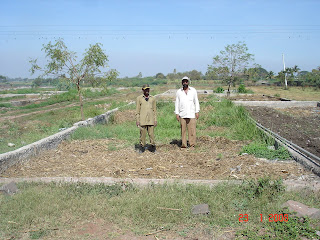Friday, July 18, 2008
THE LAW OF DISORDER – NEMESIS FOR MIXED MUNICIPAL SOLID WASTE TREATMENT PLANTS
2. Unlike any other industrial feedstock (e.g., iron ore, coal, etc.) the mixed municipal solid waste is characterised by a high degree of disorder – called ‘entropy’. For instance it has high moisture content, plastics, rags, soil, sand and stones, metal fines, and at times hazardous substances. Such variable and aggressive composition demands very advanced and robust equipment for pre-processing. Secondly the ‘degree of disorder’ is also not fixed – it keeps varies from batch to batch, day to day and season to season. For instance in summer there will be high silt/grit content while in Monsoon there will be high moisture levels. Therefore the pre-processing plant can not deliver a reliable and consistent output which could be guaranteed to be one hundred percent suitable round the year for feeding into a downstream ‘waste-to-energy’ plant or a ‘compost’ plant or an ‘RDF’ plant. Moreover, because of this ‘high disorder’, the equipment itself is subjected to high degree of corrosion, abrasion and therefore high wear and tear entailing frequent and costly repairs and replacements. Thus unlike an ore processing industrial plant, here the ‘feedstock’ is highly unreliable.
3. The society which generates the waste or let’s says the ‘feedstock’ for our processing plants is also characterised by a ‘high degree of disorder’. A large percentage of the population is either uneducated, unaware or unconcerned about segregation of waste. The waste is neither stored at home nor is it properly packed and disposed off in plastic bags. Efforts to bring about community awareness have not been able to bring about the desired response and the producers (householders) are not even prepared to pay a small price to the door collection service providers who helps in reducing the ‘disorder’. Further, open disposal at waste storage depots/ community collection point (or ‘Dalao’ as it is called in India) invites cattle to increase the disorder further and the monsoon adds an extra dose of moisture. Many towns are not able to control mixing of construction debris, drain silt, domestic hazardous waste, hospital waste, etc. at the Dalao’ . Thus the ‘disorder of feedstock’ starts from its place of generation/collection and continues all the way up to the dump yard and the processing plant.
4. On top of all this, we try to convince ourselves that this ‘highly disordered’ feedstock can be processed by a ‘low cost appropriate technology’. As a matter of fact, on the contrary the conventional wisdom says that it would require a much higher degree of robustness of the processing technology from the points of view equipment specifications, energy input, process control and environmental impact. Unfortunately the widely proclaimed ‘windrow’ technology for composting scores very low on all the four criterion.
5. In the backdrop of this ‘disorderliness’, it is not surprising to find a large number of failed initiatives for converting ‘waste-to-energy’ or ‘waste-to-wealth’ across the country. As a matter of fact, it needs to be emphasised and must be realised sooner than later that these initiatives are taking us nowhere but leading to ‘Waste-of-Energy’ and ‘Waste-of-Wealth’. Without harbouring any expectations of making gainful recovery (in financially viable terms as in an industrial enterprise) from the Indian mixed MSW (from where the rag pickers and the cows have taken out the last vestige of recoverables), it must be recognised that it is fit for only giving a ‘dignified burial’, i.e., safe disposal in a sanitary landfill, so as to protect environment and public health. Otherwise we will continue to experience not just the usual dysentery, viral and bacterial diarrhoea, typhoid and conjunctivitis, but more deadly versions of epidemics, e.g., gastro-enteritis, trachoma, laptospirosys, plague, typhus, salmonella, filariasis, malaria, tapeworm and trichonosis.
Asit Nema M.Tech. (Env. Engg., IIT Kanpur), M.Sc. (Sanitary Engg., Netherlands)
Director
Foundation for Greentech Environmental Systems
K-12, Sarita Vihar
New Delhi 110 076
Ph 011 4105 4084 / 2697 4941
Wednesday, July 16, 2008
THE CHALLENGES OF VERMICOMPOSTING





Fundamentally ‘vermicomposting’ represents one of the most ‘Earth Friendly’ ‘Ecological Sanitation’ solutions and no wonder many agencies and individuals are enamoured with the docile earthworms with regard to their capacity to convert kitchen waste (as against mixed municipal solid waste) into useful compost. There is no doubt about the capability of earthworms to devour the food left-over and other vegetable waste and in the process deliver a very homogeneous, uniform, pleasant textured and sweet smelling compost. However, in order to deliver such a high quality product, the earthworms need a great deal of care and protection. A number of well intentioned initiatives at the level of individuals, communities and even municipalities have been discontinued due to a number of external risk factors. A set of concerns, problems and risk factors are described hereunder:
- Earthworms are very sensitive to temperature variations and require humid and shady place to work effectively. Temperature within the vermibeds/waste piles needs to be maintained within the ideal range of 20-28°C otherwise the earthworms start dieing. Typically in peak summer and winter seasons a higher rate of die-off is observed if the vermibeds are not well covered and protected. Secondly, aerobic composting being an exothermic process where the temperature in the core of a high waste pile rises beyond 55°C, it does not offer a very conducive environment for earthworms to survive. It is essentially to avoid heat build up that it is recommended to use (a) pre- or semi-digested organic waste, (b) restrict the height of vermibeds as low as 30-45 cm, (c) provide a shed of thatch and (d) cover the vermibeds with moist gunny bags to keep the army of earthworms cool.
- The requirement of feeding pre-digested food waste entails provision of a pre-processing section with 15-30 days holding capacity. Secondly restriction on height of vermibeds (as against large windrows) translates into large area requirement for a community level treatment facility. Easy availability of land is a limitation and therefore either the throughput is restricted or the vermibeds get overloaded. A combination of overload and raw waste as feedstock results in higher die-off of earthworms.
- Earthworms are also not comfortable under high moisture conditions. In monsoon an uncovered facility experiences higher die-off.
- Earthworms are easy targets of predators and therefore vermibeds need to be well ‘guarded’ against centipedes, snakes, rodents, birds, hens and red ants. Generally to avoid ants, every vermibed has a ‘moat’ of water all around !!
- It has been found that the indigenous species and soil burrower category of earthworms are not effective for direct devouring of kitchen waste. Exotic species such as Eudrillus euginiae, Eisenia foetida and Perionyx excavatus which are found to be most suitable are required to be cultured or purchased. The market rate of exotic species varies between Rs. 300 – 1000/kg of earthworms. Given the risk of predation and sensitivity to climatic factors, no wonder some agree-entrepreneurs are more interested in selling the earthworms rather than setting up a vermicomposting operation !
Once an individual or a large facility operator experiences colony die-off, he/she does not get second time motivated to procure a new batch of earthworms at the prevailing market rates and recolonise the vermibeds. There are so many uncertainties involved. And to ward them off, a good deal of care is required. Because of these reasons, it is generally found that sooner or later most of the vermicomposting initiatives are abandoned.
Further, because of the inherent uncertainties, the vermicomposting systems are not suitable for scaling up to treat large quantities of mixed MSW at ward or city level. It is understandable that these very reasons contributed to abandoning of a plant which was ambitiously designed for 400 MT/day capacity at the Devnar landfill site in 1992-93 in Mumbai.
